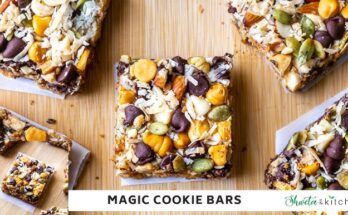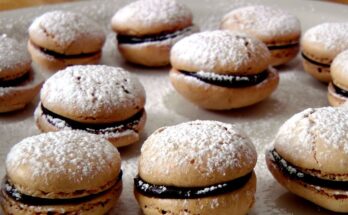Cannoli Filling Recipe: Ah, the cannoli—a crispy, golden shell filled with creamy, luscious sweetness. Originating from Sicily, cannoli are one of Italy’s most famous desserts. These tubular treats are often associated with celebrations, family gatherings, and, of course, delicious indulgence. But while the shell delivers that satisfying crunch, it’s the filling that steals the spotlight. That smooth, rich, slightly sweet filling is what makes a cannoli truly unforgettable.
Cannoli are traditionally served with a dusting of powdered sugar, sometimes with chocolate chips or crushed pistachios on either end. The contrast of textures—the crisp shell with the creamy center—is what makes this dessert iconic. So, if you’re here for the good stuff (aka the filling), you’re in the right place!
The Importance of the Filling
Let’s not sugarcoat it—literally. The filling is the soul of the cannoli. A perfect filling is creamy but not watery, sweet but not overwhelming, and flavorful without being overly complicated. Many bakeries try to cut corners by using pre-made mixtures or over-sweetened versions that lack the authentic taste of Italy. The real deal? It’s all about fresh ricotta, balanced sweetness, and optional flavorings that elevate without overpowering.
Ingredients for Traditional Cannoli Filling
Ricotta Cheese – The Star of the Show
The best cannoli filling starts with high-quality whole milk ricotta cheese. It’s light, creamy, and has a mild flavor that pairs perfectly with sweet ingredients. But here’s the trick—not all ricotta is created equal. Some store-bought versions can be too watery, which ruins the consistency of your filling. Always go for a thick, firm ricotta or drain it overnight to remove excess moisture.
You’ll need about 2 cups of ricotta cheese for a batch of filling. That should be enough for 10–12 cannoli shells.
Additional Flavor Enhancers
Besides the base, it’s the little extras that make the filling special. Here’s a basic list of what you might want to include:
- Powdered Sugar – for a smooth sweetness that blends easily
- Vanilla Extract – adds warmth and depth
- Cinnamon or Nutmeg – for a subtle spice note
- Mini Chocolate Chips – for texture and chocolatey bites
- Orange or Lemon Zest – gives a citrusy zing
- Pistachios – finely chopped, for nutty crunch
You can pick and choose based on your taste, but the combination of vanilla, powdered sugar, and chocolate chips is a classic for a reason.
How to Prepare Cannoli Filling – Step-by-Step Guide
Step 1: Draining the Ricotta Properly
Don’t skip this! The biggest mistake you can make is using wet ricotta. Excess moisture leads to a runny filling that won’t hold up inside your shells. Place the ricotta in a cheesecloth or fine mesh strainer over a bowl. Let it drain in the fridge for at least 4 hours—preferably overnight. You’ll be surprised how much liquid comes out.
Once drained, give it a quick stir to fluff it up before moving on to the next step.
Step 2: Sweetening the Ricotta
Transfer the drained ricotta to a mixing bowl. Add in 3/4 to 1 cup of powdered sugar depending on how sweet you like your filling. Start slow—you can always add more later. Using powdered sugar helps maintain a smooth texture (granulated sugar can make it gritty).
Mix with a hand mixer on low speed until fully blended and creamy.
Step 3: Mixing in the Flavors
Now it’s time to get fancy. Add in 1 to 2 teaspoons of vanilla extract. If you’re using zest, go for about 1 teaspoon of orange or lemon zest. A pinch of cinnamon or nutmeg? Totally optional but delicious. Fold in your mini chocolate chips or chopped nuts last.
Mix until everything is evenly distributed. You want a thick, spreadable consistency—not runny and definitely not stiff.
Pro Tip: Chill the filling for at least 30 minutes before piping into shells. It helps the flavors meld together and makes the texture more firm and pipe-able.
Variations of Cannoli Filling
Chocolate Chip Cannoli Filling
If you’re a chocoholic, this variation is going to be your favorite. The creamy ricotta base pairs beautifully with the rich taste of chocolate. Mini chocolate chips are ideal because they distribute more evenly throughout the filling, giving you that perfect crunch in every bite. To make this version, follow the standard filling recipe, and at the final mixing stage, fold in about 1/2 cup of mini semi-sweet chocolate chips.
Want it even more indulgent? Drizzle in a tablespoon of melted dark chocolate and swirl it into the mixture for a marbled look. It adds not just flavor, but also a fun visual effect. This variation is particularly popular with kids and perfect for parties or special occasions.
Pistachio Cannoli Filling
For a slightly nutty, sophisticated twist, pistachio cannoli filling is a must-try. Pistachios have a subtle earthy flavor that complements the ricotta’s creaminess beautifully. You can either blend some pistachio paste into the mixture or fold in finely chopped roasted pistachios.
A good starting point is adding 1/4 cup of pistachio paste or 1/3 cup of chopped pistachios into your sweetened ricotta. You can even roll the ends of your filled cannoli in extra crushed pistachios for added texture and color. This version is a crowd-pleaser and feels a little more “gourmet” if you’re trying to impress guests.
Mascarpone Twist
If you’re feeling adventurous or want a richer version, try adding mascarpone cheese to your filling. Mascarpone gives the mixture a velvety texture and a slight tang, almost like cheesecake. Combine one part mascarpone to two parts ricotta, then proceed with the usual ingredients—powdered sugar, vanilla, and mix-ins.
This twist is perfect if you’re looking to elevate your cannoli game. The result is an ultra-smooth, luxurious filling that’s a bit denser and creamier. You can also make this filling your base for other variations like raspberry or espresso flavors.
Pro Tips for Perfect Cannoli Filling
Avoiding Watery Texture
Watery cannoli filling is the number one enemy of a great dessert. As we mentioned earlier, draining your ricotta is non-negotiable. But here are a few more tricks to keep things thick and creamy:
- Always use whole milk ricotta, never low-fat.
- If your mixture still seems loose, add a little more powdered sugar or a spoonful of instant vanilla pudding mix as a stabilizer.
- Keep the filling chilled until you’re ready to use it.
Watery filling not only ruins the texture but can also make the shell soggy. And nobody wants a soggy cannoli, right?
Achieving a Smooth Consistency
Texture matters just as much as taste. For the smoothest filling, after draining your ricotta, you can run it through a food processor for a minute or two. This breaks down any graininess and makes the base ultra-creamy.
Another trick? Sift your powdered sugar before mixing. It blends better and avoids clumps. Use a silicone spatula to fold ingredients in gently to preserve the airiness. And remember—don’t overmix. Overmixing can actually make the filling watery as well.
Storing and Filling Cannoli Shells
Timing is everything. Cannoli shells are meant to be crispy, and the longer they sit filled, the softer they’ll get. For best results:
- Fill the shells just before serving.
- Store the filling in an airtight container in the refrigerator for up to 3 days.
- If prepping for an event, store the empty shells in a dry, sealed container and the filling separately.
Want a pro touch? Use a piping bag with a star tip to fill the shells—it not only looks impressive but makes for easy, mess-free serving.
FAQs about Cannoli Filling Recipe
1. What is cannoli filling made of?
Traditional cannoli filling is made with ricotta cheese, powdered sugar, and vanilla extract. Some variations include mascarpone, chocolate chips, citrus zest, or cinnamon for extra flavor.
2. Can I use cream cheese instead of ricotta?
Yes, but it will change the texture and flavor. Cream cheese is denser and tangier than ricotta. For a smoother, richer filling, you can use a mix of both.
3. How do I keep my cannoli filling from being runny?
Always drain your ricotta overnight using cheesecloth or a fine-mesh sieve to remove excess moisture. This keeps the filling thick and creamy.
4. Can I make the filling ahead of time?
Absolutely. Cannoli filling can be made up to 2 days in advance. Just keep it in an airtight container in the fridge and fill the shells right before serving.
5. Can I freeze cannoli filling?
Freezing is not ideal, especially for ricotta-based fillings, as the texture can become grainy when thawed. It’s best enjoyed fresh.
6. Do I need to sweeten the ricotta?
Yes! Cannoli filling is meant to be sweet. Powdered sugar blends best and gives the smoothest texture.
7. How long does cannoli filling last in the fridge?
It stays fresh for about 3–4 days when properly stored in the refrigerator.
8. Can I add flavorings to the filling?
Definitely! Popular additions include almond extract, orange zest, cocoa powder, or even a splash of liqueur like Marsala or Amaretto.
Conclusion
There you have it—everything you need to know about making the perfect cannoli filling from scratch. Whether you’re sticking to tradition with a simple ricotta-vanilla mixture or branching out into chocolate chip, pistachio, or mascarpone versions, the filling is where the magic happens.
Cannoli may look fancy, but once you master the filling, they’re actually one of the easiest and most satisfying desserts to make. Just remember the key tips: drain your ricotta well, mix in your flavors with care, and always fill right before serving.
So go ahead—grab those cannoli shells and let your creativity (and sweet tooth) run wild. You’re now equipped to whip up a batch of delicious, bakery-worthy cannoli right in your own kitchen.



